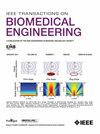基于深度学习的高动态范围多光谱荧光寿命成像饱和补偿。
IF 4.5
2区 医学
Q2 ENGINEERING, BIOMEDICAL
引用次数: 0
摘要
在多光谱荧光寿命成像(FLIm)中,在所有光谱通道中实现一致的成像质量对于准确识别各种荧光团至关重要。然而,由于检测系统固有的动态范围有限,这些基本测量经常受到饱和伪影的影响。为了解决这个问题,我们提出了satcomplimnet,这是一个基于深度学习的网络,专门用于校正多光谱FLIm中的饱和伪影,促进高动态范围应用。利用生成对抗网络,SatCompFLImNet有效地补偿饱和荧光信号,确保在各种饱和度下精确的寿命测量。通过模拟和实际数据的广泛验证,SatCompFLImNet在校正饱和伪影、提高信噪比和保持寿命测量的保真度方面表现出了卓越的能力。通过在各种饱和条件下进行可靠的荧光寿命测量,satcompfllimnet为改进诊断工具和更深入地了解生物过程铺平了道路,使其成为组织表征和疾病发病机制的研究和临床诊断的关键进展。本文章由计算机程序翻译,如有差异,请以英文原文为准。
Deep Learning-Based Saturation Compensation for High Dynamic Range Multispectral Fluorescence Lifetime Imaging
In multispectral fluorescence lifetime imaging (FLIm), achieving consistent imaging quality across all spectral channels is crucial for accurately identifying a wide range of fluorophores. However, these essential measurements are frequently compromised by saturation artifacts due to the inherently limited dynamic range of detection systems. To address this issue, we present SatCompFLImNet, a deep learning-based network specifically designed to correct saturation artifacts in multispectral FLIm, facilitating high dynamic range applications. Leveraging generative adversarial networks, SatCompFLImNet effectively compensates for saturated fluorescence signals, ensuring accurate lifetime measurements across various levels of saturation. Extensively validated with simulated and real-world data, SatCompFLImNet demonstrates remarkable capability in correcting saturation artifacts, improving signal-to-noise ratios, and maintaining fidelity of lifetime measurements. By enabling reliable fluorescence lifetime measurements under a variety of saturation conditions, SatCompFLImNet paves the way for improved diagnostic tools and a deeper understanding of biological processes, making it a pivotal advancement for research and clinical diagnostics in tissue characterization and disease pathogenesis.
求助全文
通过发布文献求助,成功后即可免费获取论文全文。
去求助
来源期刊

IEEE Transactions on Biomedical Engineering
工程技术-工程:生物医学
CiteScore
9.40
自引率
4.30%
发文量
880
审稿时长
2.5 months
期刊介绍:
IEEE Transactions on Biomedical Engineering contains basic and applied papers dealing with biomedical engineering. Papers range from engineering development in methods and techniques with biomedical applications to experimental and clinical investigations with engineering contributions.
 求助内容:
求助内容: 应助结果提醒方式:
应助结果提醒方式:


